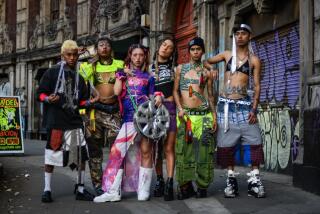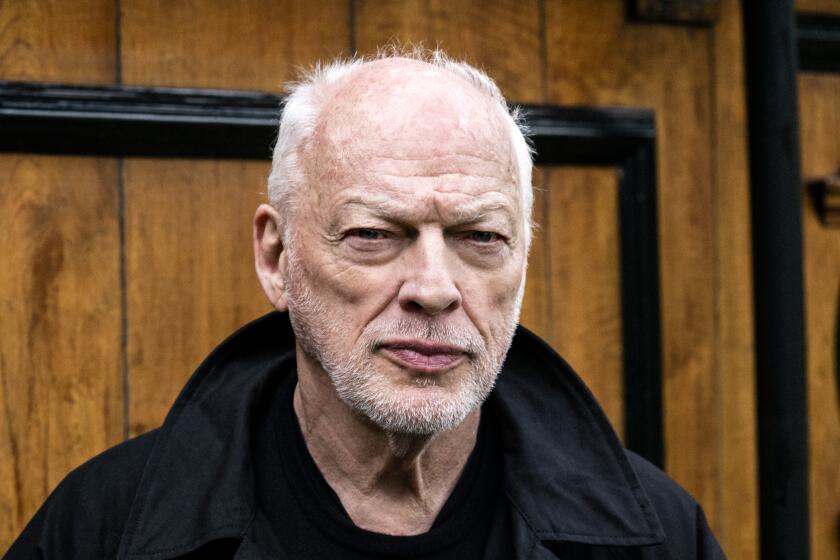The Underground Surfaces in Urb : Culture: The gritty L.A.-based tabloid is hot among twentysomethings and teens who follow the illegal club scene.
- Share via
LOS ANGELES — ‘DANGER ACID.”
“Lunatic.”
“hip hop underground life.”
The signs on the wall do tell: This is no office-proper for a magazine publisher. There’s no secretary, coffee maker, fancy framed art or even carpeting.
“This place is raw,” says Raymond Leon Roker, satisfied. “A raw warehouse.”
It’s perfect.
As home to Roker’s Urb magazine, these cold 1,500 square feet of space--which used to house a motorcycle repair shop--are the spiritual center of a small but growing society of teen-agers and twentysomethings whose culture is emerging from often illegal underground warehouse parties.
The new Jefferson Boulevard office (Roker used to work out of his apartment) heralded Urb’s second year. During its first, the freebie magazine’s circulation climbed from as many copies as would fit in Roker’s Honda Accord (a few thousand) to 20,000 monthly. A colorful, stapled, newsprint-quality tabloid, Urb--shorthand for urban --not only has documented the blooming underground culture, it has helped it blossom along the coast from Rosarito to Sausalito.
Available at nearly 300 coffee shops, clubs and clothing stores in San Diego, Orange County, Los Angeles and San Francisco, Urb is the center of this subterranean revolution and its music, clothes and drugs that have hit mainstream clubs and stores along the coast.
The magazine, which began turning a profit last June, is also known by word-of-mouth in places as far away as Japan, where Surf & Street magazine did a profile of the L.A. youth scene and dedicated considerable space to Urb.
Underground parties, called raves for a similar scene in England, have been around Southern California for more than two years. Often held without permits in abandoned warehouses and outdoors, the parties allow underage drinking, a free flow of drugs, T-shirt peddling, wild aerobic-like dancing and a general impression of lawlessness.
The scene pairs African-American and European-bred music with a multicultural audience that Roker somewhat equates with the energy and aimlessness of the ‘70s punk-rock scene.
Urb editors say their publication, which features underground party reports, club and music reviews, musician’s profiles and fashion features, is simply documenting a growing phenomenon. “It just so happens that it is a very exciting time for the urban arena--raves, clubs, hip-hop music,” says managing editor Jason Bentley, a Loyola Marymount University student who also works as a deejay at parties and occasionally on radio.
But the magazine also has its critics. Some hipsters don’t like its broadening focus that includes culture outside the underground. And some police and fire officials don’t like the magazine’s promotion of a culture where drug dealers roam and the underage play.
The magazine’s success certainly hasn’t hurt the spread of that underground culture and its almost hedonistic ethic. You can attend underground-style clubs any weekend at legal locales from the border to the Bay Area. You can hear techno--the fast-beat dance music of the underground--at clubs ranging from L.A.’s upscale Roxbury to San Diego’s laid-back Smile. And you can buy Fresh Jive--an underground clothing label--on Melrose and in downtown San Diego.
“We determine what’s going on,” says Bentley, who’s not shy in promoting Urb’s influence. “We don’t cater to an audience; the audience caters to us.”
Hyperbole notwithstanding, Urb attracts followers because it has a tendency to roll a forefinger at trend-crazed youths and say, “ Pssst . Check this out--it’s taboo.”
It reports from underground parties with names like Infinity, Moonshine and Truth, and makes them legendary happenings. “The warehouse was of beautiful proportions,” read an Urb report. “It was the kind with lots of nooks, closets, hiding places, make-out corners, you get the picture.”
Thanks to Urb’s advertisements, the parties, once accessible only to underground groupies, now are open to the young masses. One ad promises “the highest level of insanity” and offers a phone number to call for more information. It was designed by Roker and bears the Urb logo.
But for Roker, the scene is peripheral. Music started his urban crusade.
Born in Nassau, Bahamas, but raised stateside, Roker is a dark and lanky 23-year-old graffiti artist who came to Los Angeles from New Orleans with his mother in 1980. He’s quiet, except when it comes to his art, which, like his magazine, is loud. Like others in this underground culture, Roker detests yuppies, malls and the suburbs, condemning them as the cornerstones of some kind of perverse, capitalistic corruption in America.
He rails aimlessly on such diverse things as air conditioners (“polluting the environment”) meat (“encourages factory farming”) and coffee and alcohol (“People are raised on drugs; they’re all addicted”).
Ideas aside, Roker took $3,000 he had saved, his street-art skills and his knowledge of graphic design (he studied two years at Los Angeles Trade Technical College), mixed it with his love for rap music, and voila ! Urb--loud, colorful and sassy--was born.
Hip-hop (James Brown-influenced rap) and other rap-affiliated forms of music-- raggamuffin (reggae rap) and house (soulful dance music)--were popular with the underground’s ethnically mixed audience. The magazine’s coverage of rap went hand-in-hand with the scene and Urb became the ink of the underground.
The magazine’s music reviews are fairly simple and raw: Reads an early critique of Rapper Ice Cube: “ ‘Kill at Will’ focuses on the realities of life and death and offers . . . personal insights revealing positive messages to the rap community.”
Urb also profiles leading artists in underground music--figures from South-Central L.A.’s gangster-rap clique to Belgium’s techno. Other publications just weren’t tuned in.
Editors have since expanded Urb’s influence into club coverage and the street-fashion that has invaded the underground. Today the magazine has five editors, a photographer and several photo and news contributors based in San Diego, Los Angeles and San Francisco. It covers the L.A.-area underground scene with its column “Da Scoop; Illicit Klub Affairs” and San Diego happenings with its “San Diego Cklub Stuffs” column. (Yes, that’s the way they spell.) Its fashion stories have chronicled the street looks--baseball caps, flannel shirts, baggy gangster pants--that are also finding their way into mainstream.
For its audience, Urb is a barometer of hipness: It was on the scene at the Southland’s summer raves long before MTV declared that the first European-style rave had hit the United States in the form of a slick party on Catalina Island. It discovered techno music long before Santa Monica station MARS-FM (103.1) started playing the electronic sound. And the magazine devoted early coverage to numerous hip-hop acts that have since become chart history.
A political voice is present, too, as Roker attempts to explain how the nation’s politics affect the culture.
Editorials have decried the Persian Gulf War and the nation’s so-called hypocrisy, and even Roker’s pet issue, meat eating. But Roker has no plans of using Urb as a political vehicle to harness the energy of the thousands of youths who dance for hours at underground parties:
“It’s not that I want people to say hallelujah. I just want them to see the magazine.”
Moreover, he has no plans to expand or sell out, go glossy or start interviewing Madonna: “I look at Urb as a piece of art. And as a piece of art, I want it to be true to me.”
Urb was not the first to chart subterranean territory. Its insider aura and rebellious words follow the tradition of Wet and Slash magazines in the late 1970s and early 1980s and most recently Revolt in Style, an artsy freebie, and the Pomona-based Sensured, a magazine focused almost solely on the Southland’s underground’s events before it went out of business this year.
L.A. Weekly’s only complaint is that Urb’s editing is thin. (Indeed, incorrect spellings are easy finds, but the slang and misspellings give Roker’s publication a street-smart edge.)
And authorities who frequent underground parties to shut them down don’t criticize Urb. Rather, they blame the subculture for accommodating illegal drugs--mainly the hallucinogenic drug known as ecstasy, and nitrous oxide (laughing gas)--and enticing underage party-goers to over-capacity warehouse events that often occur without permits.
“There’s certainly a First Amendment protection and I’m not going to argue with that,” says Ken Espiau, a lieutenant in the LAPD’s Central Vice unit that often comes across warehouse parties. But he decries the warehouse-party promoters who advertise in Urb, often with the assistance of Roker’s graphic skills: “Their motivation is not to promote the community, their sole motivation is profit.”
In Urb’s defense, Roker points to a recent headline in the magazine: “Examine the Hypocrisy.” Simply put, he says, Urb accommodates guilt-free partying for an underground generation that blames the world’s ills on older generations.
“I don’t feel any responsibility for the scene,” says Roker, who doesn’t take well to criticism of Urb or the underground.
“The world is bad for kids,” he explains. “They are being taught about sexism and painkillers and accepted vices that are spouted out everyday over the television.
“How dare you point a finger at me?
“Point a finger at yourself first.”
More to Read
The biggest entertainment stories
Get our big stories about Hollywood, film, television, music, arts, culture and more right in your inbox as soon as they publish.
You may occasionally receive promotional content from the Los Angeles Times.







